Related Research Articles

Blackburn Aircraft Limited was a British aircraft manufacturer that concentrated mainly on naval and maritime aircraft during the first part of the 20th century.

A biplane is a fixed-wing aircraft with two main wings stacked one above the other. The first powered, controlled aeroplane to fly, the Wright Flyer, used a biplane wing arrangement, as did many aircraft in the early years of aviation. While a biplane wing structure has a structural advantage over a monoplane, it produces more drag than a monoplane wing. Improved structural techniques, better materials and higher speeds made the biplane configuration obsolete for most purposes by the late 1930s.

Curtiss Aeroplane and Motor Company was an American aircraft manufacturer originally founded in 1909 by Glenn Hammond Curtiss and Augustus Moore Herring in Hammondsport, New York. After significant commercial success in its first decades, it merged with the Wright Aeronautical in 1929 to form Curtiss-Wright Corporation.

Continental Aerospace Technologies is an aircraft engine manufacturer located at the Brookley Aeroplex in Mobile, Alabama, United States. It was originally spun off from automobile engine manufacturer Continental Motors Company in 1929 and owned by Teledyne Technologies from 1969 until December 2010. The company is now part of Aviation Industry Corporation of China (AVIC), which is a Government of the People's Republic of China state-owned aerospace company headquartered in Beijing.

The Travel Air Manufacturing Company was an aircraft manufacturer established in Wichita, Kansas, United States in January 1925 by Clyde Cessna, Walter Beech, and Lloyd Stearman.

The Luscombe 8 is a series of high-wing, side-by-side-seating monoplanes with conventional landing gear, designed in 1937 and built by Luscombe Aircraft.
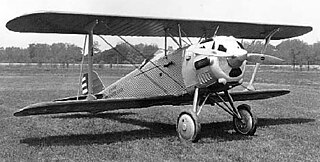
The XP-13 Viper was a prototype biplane fighter aircraft designed by the American company Thomas-Morse Aircraft Corporation. The airplane was delivered to the United States Army in 1929, but they did not adopt it.
Grahame-White was an early British aircraft manufacturer, flying school and later manufacturer of cyclecars.
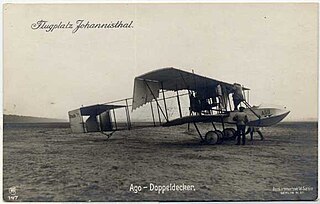
AGO Flugzeugwerke was a German aircraft manufacturing company from 1911 until 1945. The initials AGO had a variety of meanings during the company's lifetime, but in its final version stood for Apparatebau GmbH Oschersleben. At its peak, the company employed around 4,500 people.
Automobil und Aviatik AG was a German aircraft manufacturer during World War I. The company was established at Mülhausen in 1909 and soon became one of the country's leading producers of aircraft. It relocated to Freiburg in 1914 and to Leipzig in 1916 and established a subsidiary in Vienna as Österreichisch-Ungarische Flugzeugfabrik Aviatik. During the war, the company became best known for its reconnaissance aircraft, the B.I and B.II, although the Austro-Hungarian subsidiary also produced a number of its own designs, including fighters such as the D.I.

Aéroplanes Voisin was a French aircraft manufacturing company established in 1905 by Gabriel Voisin and his brother Charles, and was continued by Gabriel after Charles died in an automobile accident in 1912; the full official company name then became Société Anonyme des Aéroplanes G. Voisin. During World War I, it was a major producer of military aircraft, notably the Voisin III. After the war Gabriel Voisin abandoned the aviation industry, and set up a company to design and produce luxury automobiles, called Avions Voisin.
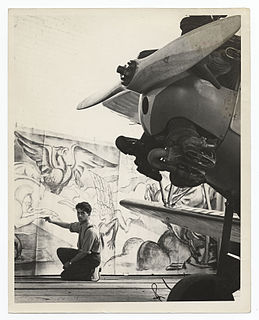
The Kinner K-5 was a popular engine for light general and sport aircraft developed by Winfield B. 'Bert' Kinner. With the boom in civilian aviation after Charles Lindbergh's transatlantic flight the K-5 sold well. The K-5 was a rough running but reliable engine and the K-5 and its derivatives were produced in the thousands, powering many World War II trainer aircraft. The K-5 was followed by the B-5, R-5 and R-55. Military engines were designated R-370
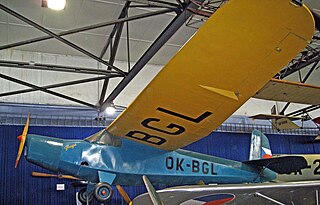
ČKD-Praga was a Czechoslovakian aircraft manufacturer. The company was founded in 1915 as an engine manufacturing company, under the designation Praga. The company started designing aircraft in 1930–31 when the designers Pavel Beneš and Miroslav Hajn came to ČKD-Praga from Avia. Their first aircraft was the Praga E-39 from 1931. It was a military trainer, with a production run of 139 aircraft. ČKD-Praga developed several aircraft over the following years, but none exceeded prototype stage.

Franco-British Aviation was an aircraft manufacturer of the early 20th century, headquartered in London and with its production facilities around Paris. Specialising in seaplanes, it was established in 1913 by Louis Schreck and André Beaumont.

The Lloyd C.II and its derivatives, the C.III and C.IV were reconnaissance aircraft produced in Austria-Hungary during the First World War. They were based on the Lloyd company's pre-war C.I design, and like it, were conventional biplanes with swept-back wings.

The unarmed Lohner B.VII and its armed derivative the C.I were military reconnaissance aircraft produced in Austria-Hungary during World War I. They were the ultimate developments in a family of aircraft that had begun with the B.I prior to the outbreak of war, and were the first members of that family that proved suitable for front-line service during the conflict. Like their predecessors, the B.VII and C.I were conventional biplanes with characteristic swept-back wings.

The Texas Aero Corporation of Temple, Texas was formed about 1927 to construct passenger and mail light aircraft. The company's origin can be traced back to George W. Williams Texas Aero Manufacturing Company of 1911.
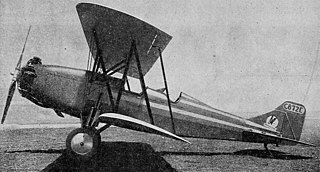
The American Eagle Phaeton was an American three seat, single engine sports biplane produced from 1929 until American Eagle failed financially in 1932. About 34 were built.
References
- 1 2 Eckland, K.O. (May 2, 2009). "Aircraft Ab - Ak". aerofiles.com. Archived from the original on December 5, 2012. Retrieved August 9, 2014.
- 1 2 Gunston 2005, p. 6.
- 1 2 3 Grey, C.G. (ed): Jane's All The World's Aircraft 1929, page 235c. Sampson, Low, Manton and Company, Limited, 1929
- ↑ Faurote, Fay Leone, Aircraft Year Book for 1930, American Aviation Publications, 1930, pg 76
- Gunston, Bill (2005). World Encyclopedia of Aircraft Manufacturers (Second ed.). Stroud, UK: Sutton Publishing. ISBN 0-7509-3981-8.